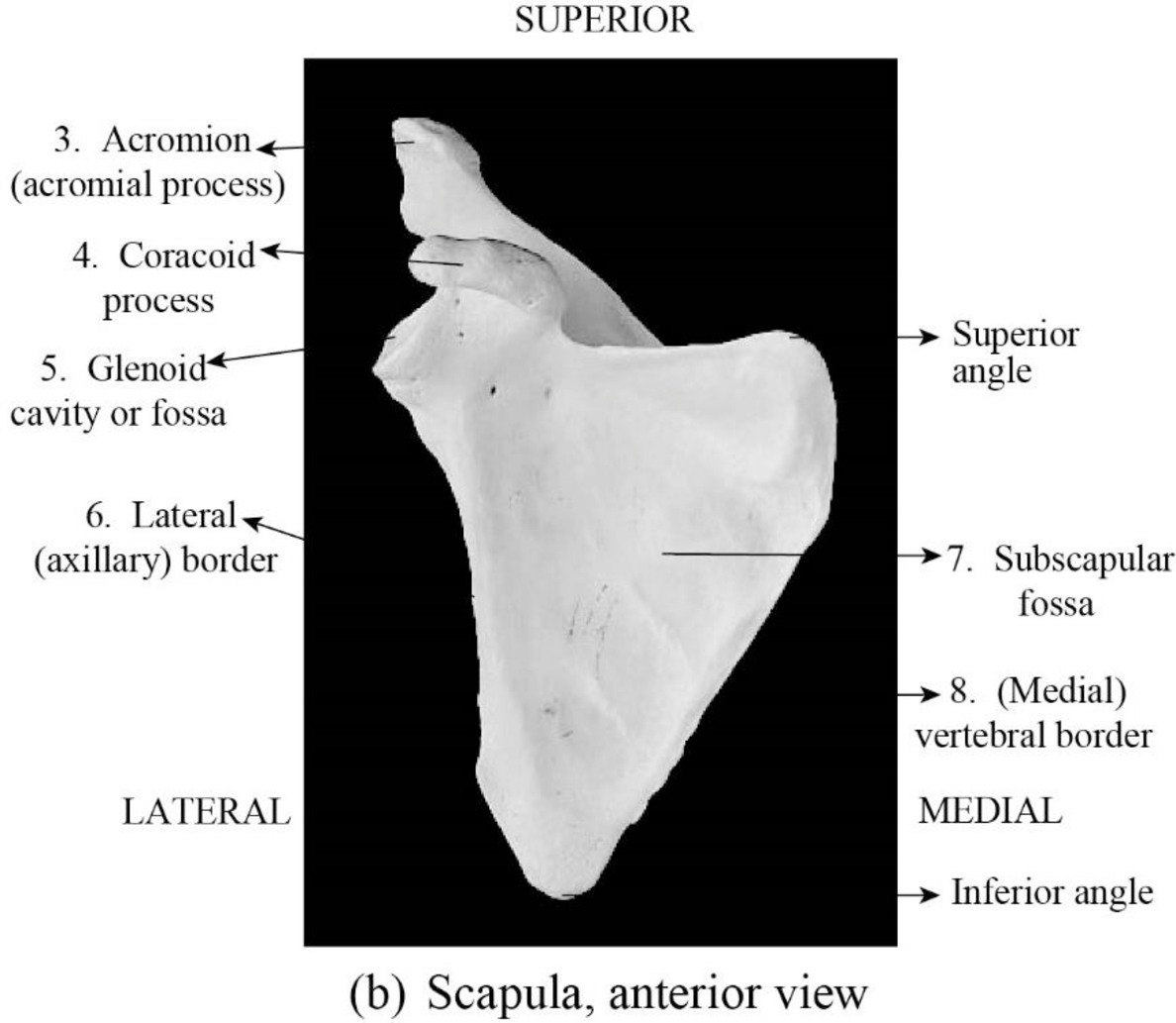
Concept explainers
To label: The parts of the clavicle in Figure 10.2 (a).
Introduction: Pectoral girdles are otherwise called shoulder girdle and they are the set of bones. An upper limb is attached to the axial skeleton by each pectoral girdle. Each shoulder girdle or pectoral girdle is composed of a clavicle and a scapula.
Answer to Problem 1.1BGL
Pictorial representation:

Fig1: The parts of the clavicle
Explanation of Solution
1. Acromial end: The acromial end is the flattened lateral end. It is anchored to the coracoid process by trapezoid ligaments and conoid. It articulates with the acromion.
2. Sternal end: The sternal end is the enlarged medial end. It articulates with manubrium sterni.
To label: The parts of scapula in Figure 10.2 (b).
Answer to Problem 1.1BGL
Pictorial representation:

Fig 2: The parts of the scapula anterior view
Explanation of Solution
3. Acromion (acromial process): Acromion is a portion of the scapula and it is found at the shoulder peak. The shape of the acromion is a triangle and it protrudes laterally. The acromion is otherwise referred as acromion process, which articulates with the collar bone or clavicle to form the acromioclavicular joint.
4. Coracoid process: The coracoid process is a thick, long curved projection attached by a broad base to the upper portion of the neck of the scapula.
5. Glenoid cavity or fossa: Glenoid cavity is a portion of the shoulder. It is depression inferior to acromion. The glenoid cavity is otherwise called a glenoid fossa of the scapula.
6. Lateral (axillary) border: The lateral border is a structural feature on the bone of scapula or border near the axilla. The lateral border of the scapula is also called an axillary border.
7. Subscapular fossa: Subscapular fossa is the concave depression on the anterior surface of the scapula. It provides origin to the subscapularis muscle. The subscapular fossa is otherwise called the shoulder bone.
8. (medial) vertebral border: The vertebral border is the edge or margin of scapula near the vertebral column. It extends to the inferior angle from a superior angle.
To label: The parts of the clavicle in Figure 10.2 (c).
Answer to Problem 1.1BGL
Pictorial representation:

Fig1: The parts of the scapula posterior view
Explanation of Solution
9. Supraspinous fossa: Supraspinous fossa is a depression superior to the spine. It provides origin to the supraspinatus muscle.
10. Infraspinous fossa: Infraspinous fossa is the depression or hollow on the dorsal aspect inferior to the spine. It mainly provides attachment to the infraspinatus muscle.
11. Acromion (acromial process): Acromion is the portion of the scapula and it is found at the shoulder peak. The acromion is otherwise referred as acromion process, which articulates with the collar bone or clavicle to form the acromioclavicular joint.
12. Spine of the scapula: The spine of the scapula is otherwise called a scapular spine. It is a sharp ridge present on the posterior side.
13. Glenoid cavity or fossa: Glenoid cavity is otherwise called a glenoid fossa of the scapula. The glenoid cavity is a portion of the shoulder. It is a depression inferior to acromion.
Want to see more full solutions like this?
Chapter 10 Solutions
Laboratory Manual for Anatomy and Physiology, 6e Loose-Leaf Print Companion
- What is this?arrow_forwardMolecular Biology A-C components of the question are corresponding to attached image labeled 1. D component of the question is corresponding to attached image labeled 2. For a eukaryotic mRNA, the sequences is as follows where AUGrepresents the start codon, the yellow is the Kozak sequence and (XXX) just represents any codonfor an amino acid (no stop codons here). G-cap and polyA tail are not shown A. How long is the peptide produced?B. What is the function (a sentence) of the UAA highlighted in blue?C. If the sequence highlighted in blue were changed from UAA to UAG, how would that affecttranslation? D. (1) The sequence highlighted in yellow above is moved to a new position indicated below. Howwould that affect translation? (2) How long would be the protein produced from this new mRNA? Thank youarrow_forwardMolecular Biology Question Explain why the cell doesn’t need 61 tRNAs (one for each codon). Please help. Thank youarrow_forward
- Molecular Biology You discover a disease causing mutation (indicated by the arrow) that alters splicing of its mRNA. This mutation (a base substitution in the splicing sequence) eliminates a 3’ splice site resulting in the inclusion of the second intron (I2) in the final mRNA. We are going to pretend that this intron is short having only 15 nucleotides (most introns are much longer so this is just to make things simple) with the following sequence shown below in bold. The ( ) indicate the reading frames in the exons; the included intron 2 sequences are in bold. A. Would you expected this change to be harmful? ExplainB. If you were to do gene therapy to fix this problem, briefly explain what type of gene therapy youwould use to correct this. Please help. Thank youarrow_forwardMolecular Biology Question Please help. Thank you Explain what is meant by the term “defective virus.” Explain how a defective virus is able to replicate.arrow_forwardMolecular Biology Explain why changing the codon GGG to GGA should not be harmful. Please help . Thank youarrow_forward
- Stage Percent Time in Hours Interphase .60 14.4 Prophase .20 4.8 Metaphase .10 2.4 Anaphase .06 1.44 Telophase .03 .72 Cytukinesis .01 .24 Can you summarize the results in the chart and explain which phases are faster and why the slower ones are slow?arrow_forwardCan you circle a cell in the different stages of mitosis? 1.prophase 2.metaphase 3.anaphase 4.telophase 5.cytokinesisarrow_forwardWhich microbe does not live part of its lifecycle outside humans? A. Toxoplasma gondii B. Cytomegalovirus C. Francisella tularensis D. Plasmodium falciparum explain your answer thoroughly.arrow_forward
- Select all of the following that the ablation (knockout) or ectopoic expression (gain of function) of Hox can contribute to. Another set of wings in the fruit fly, duplication of fingernails, ectopic ears in mice, excess feathers in duck/quail chimeras, and homeosis of segment 2 to jaw in Hox2a mutantsarrow_forwardSelect all of the following that changes in the MC1R gene can lead to: Changes in spots/stripes in lizards, changes in coat coloration in mice, ectopic ear formation in Siberian hamsters, and red hair in humansarrow_forwardPleiotropic genes are genes that (blank) Cause a swapping of organs/structures, are the result of duplicated sets of chromosomes, never produce protein products, and have more than one purpose/functionarrow_forward
 Human Anatomy & Physiology (11th Edition)BiologyISBN:9780134580999Author:Elaine N. Marieb, Katja N. HoehnPublisher:PEARSON
Human Anatomy & Physiology (11th Edition)BiologyISBN:9780134580999Author:Elaine N. Marieb, Katja N. HoehnPublisher:PEARSON Biology 2eBiologyISBN:9781947172517Author:Matthew Douglas, Jung Choi, Mary Ann ClarkPublisher:OpenStax
Biology 2eBiologyISBN:9781947172517Author:Matthew Douglas, Jung Choi, Mary Ann ClarkPublisher:OpenStax Anatomy & PhysiologyBiologyISBN:9781259398629Author:McKinley, Michael P., O'loughlin, Valerie Dean, Bidle, Theresa StouterPublisher:Mcgraw Hill Education,
Anatomy & PhysiologyBiologyISBN:9781259398629Author:McKinley, Michael P., O'loughlin, Valerie Dean, Bidle, Theresa StouterPublisher:Mcgraw Hill Education, Molecular Biology of the Cell (Sixth Edition)BiologyISBN:9780815344322Author:Bruce Alberts, Alexander D. Johnson, Julian Lewis, David Morgan, Martin Raff, Keith Roberts, Peter WalterPublisher:W. W. Norton & Company
Molecular Biology of the Cell (Sixth Edition)BiologyISBN:9780815344322Author:Bruce Alberts, Alexander D. Johnson, Julian Lewis, David Morgan, Martin Raff, Keith Roberts, Peter WalterPublisher:W. W. Norton & Company Laboratory Manual For Human Anatomy & PhysiologyBiologyISBN:9781260159363Author:Martin, Terry R., Prentice-craver, CynthiaPublisher:McGraw-Hill Publishing Co.
Laboratory Manual For Human Anatomy & PhysiologyBiologyISBN:9781260159363Author:Martin, Terry R., Prentice-craver, CynthiaPublisher:McGraw-Hill Publishing Co. Inquiry Into Life (16th Edition)BiologyISBN:9781260231700Author:Sylvia S. Mader, Michael WindelspechtPublisher:McGraw Hill Education
Inquiry Into Life (16th Edition)BiologyISBN:9781260231700Author:Sylvia S. Mader, Michael WindelspechtPublisher:McGraw Hill Education





